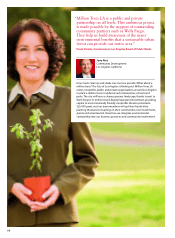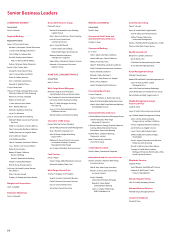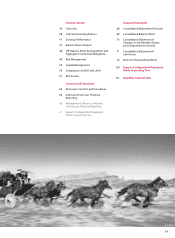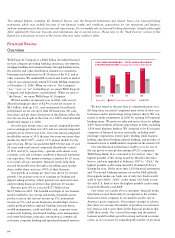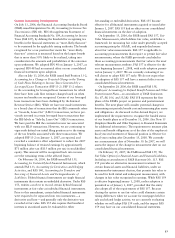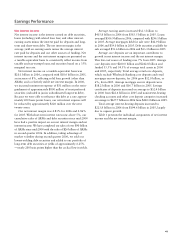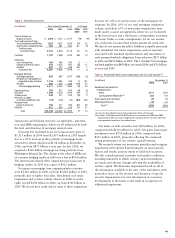Wells Fargo 2006 Annual Report Download - page 39
Download and view the complete annual report
Please find page 39 of the 2006 Wells Fargo annual report below. You can navigate through the pages in the report by either clicking on the pages listed below, or by using the keyword search tool below to find specific information within the annual report.
37
Current Accounting Developments
On July 13, 2006, the Financial Accounting Standards Board
(FASB) issued Interpretation No. 48, Accounting for Income Tax
Uncertainties (FIN 48). FIN 48 supplements Statement of
Financial Accounting Standards No. 109, Accounting for Income
Taxes (FAS 109), by defining the threshold for recognizing tax
benefits in the financial statements as “more-likely-than-not”
to be sustained by the applicable taxing authority. The benefit
recognized for a tax position that meets the “more-likely-
than-not” criterion is measured based on the largest benefit
that is more than 50% likely to be realized, taking into
consideration the amounts and probabilities of the outcomes
upon settlement. We adopted FIN 48 on January 1, 2007, as
required. FIN 48 had no material effect on our consolidated
financial statements upon adoption.
Also on July 13, 2006, the FASB issued Staff Position 13-2,
Accounting for a Change or Projected Change in the Timing
of Cash Flows Relating to Income Taxes Generated by a
Leveraged Lease Transaction (FSP 13-2). FSP 13-2 relates
to the accounting for leveraged lease transactions for which
there have been cash flow estimate changes based on when
income tax benefits are recognized. Certain of our leveraged
lease transactions have been challenged by the Internal
Revenue Service (IRS). While we have not made investments
in a broad class of transactions that the IRS commonly refers
as “Lease-In, Lease-Out” (LILO) transactions, we have pre-
viously invested in certain leveraged lease transactions that
the IRS labels as “Sale-In, Lease-Out” (SILO) transactions.
We have paid the IRS the contested income tax associated
with our SILO transactions. However, we are continuing to
vigorously defend our initial filing position as to the timing
of the tax benefits associated with these transactions. We
adopted FSP 13-2 on January 1, 2007, as required, and
recorded a cumulative effect adjustment to reduce the 2007
beginning balance of retained earnings by approximately
$71 million after tax ($115 million pre tax) in stockholders’
equity. This amount will be recognized back into income
over the remaining terms of the affected leases.
On February 16, 2006, the FASB issued FAS 155,
Accounting for Certain Hybrid Financial Instruments, which
amends FAS 133, Accounting for Derivatives and Hedging
Activities, and FAS 140, Accounting for Transfers and
Servicing of Financial Assets and Extinguishments of
Liabilities. Hybrid financial instruments are single financial
instruments that contain an embedded derivative. Under FAS
155, entities can elect to record certain hybrid financial
instruments at fair value as individual financial instruments.
Prior to this amendment, certain hybrid financial instruments
were required to be separated into two instruments—a
derivative and host—and generally only the derivative was
recorded at fair value. FAS 155 also requires that beneficial
interests in securitized assets be evaluated for either
free-standing or embedded derivatives. FAS 155 became
effective for all financial instruments acquired or issued after
January 1, 2007. FAS 155 had no effect on our consolidated
financial statements on the date of adoption.
On September 15, 2006, the FASB issued FAS 157, Fair
Value Measurements, which defines fair value, establishes a
framework for measuring fair value under generally accepted
accounting principles (GAAP), and expands disclosures
about fair value measurements. FAS 157 is applicable to
accounting pronouncements that require or permit fair value
measurements, where the FASB previously concluded in
those accounting pronouncements that fair value is the most
relevant measurement attribute. FAS 157 is effective for the
year beginning January 1, 2008, with early adoption permit-
ted on January 1, 2007. We are currently evaluating if we
will choose to adopt FAS 157 early. We do not expect that
the adoption of FAS 157 will have a material effect on our
consolidated financial statements.
On September 29, 2006, the FASB issued FAS 158,
Employers’ Accounting for Defined Benefit Pension and Other
Postretirement Plans – an amendment of FASB Statements
No. 87, 88, 106, and 132(R). FAS 158 represents the first
phase of the FASB’s project on pension and postretirement
benefits. The next phase will consider potential changes in
determining net periodic benefit cost and measuring plan assets
and obligations. As discussed in this Annual Report, we
implemented the requirement to recognize the funded status
of our benefit plans as of December 31, 2006. (See Note 15
(Employee Benefits and Other Expenses) to Financial Statements
for additional information.) The requirement to measure plan
assets and benefit obligations as of the date of the employer’s
fiscal year-end statement of financial position is effective for
fiscal years ending after December 15, 2008. We currently
use a measurement date of November 30. In 2007, we will
assess the impact of the change in measurement date on our
consolidated financial statements.
On February 15, 2007, the FASB issued FAS 159, The
Fair Value Option for Financial Assets and Financial Liabilities,
Including an amendment of FASB Statement No. 115. FAS
159 provides an alternative measurement treatment for
certain financial assets and financial liabilities, under an
instrument-by-instrument election, that permits fair value to
be used for both initial and subsequent measurement, with
changes in fair value recognized in earnings. While FAS 159
is effective beginning January 1, 2008, earlier adoption is
permitted as of January 1, 2007, provided that the entity
also adopts all of the requirements of FAS 157. Because
electing the option to use fair value could eliminate certain
timing differences when we account for mortgages held for
sale and related hedge activity, we are currently evaluating
whether we will adopt FAS 159 early, and the impact FAS
159 may have on our consolidated financial statements.



